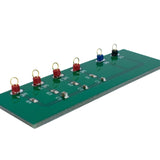Electrochemical Cells
An electrochemical cell is a device that either produces electricity from a chemical reaction, or uses electricity to initiate a non-spontaneous chemical reaction.
Our electrochemical cells have been designed for cyclic voltammetry, electrolysis and other electrochemical studies. Combined with the Ossila Potentiostat, our electrochemistry range has everything you need to perform cyclic voltammetry in your commercial, academic or teaching lab.
Whether you need temperature control, inlets for degassing, a luggin capillary for improving the accuracy of your potential measurements or h-type cell separation, we have you covered.
| Feature | Gas Inlet | Water Bath | Luggin Capillary | H-type Separation |
|---|---|---|---|---|
| Function | Degassing the system | Temperature Control | Minimize potential drop | Separate reaction environments |
| Standard Electrochemical Cell | ||||
| Electrochemical Cell with Water Bath | ||||
| Electrochemical Cell with Luggin Capillary | ||||
| H-type Electrochemical Cell | ||||
| H-type Electrochemical Cell with Water Bath |
Browse Electrochemical Cells
Related categories: photoelectrochemical cells, potentiostat, equipment accessories, electrodes, electrochemistry
Filter by feature:
Resources and Support
 What is an Electrochemical Cell?
What is an Electrochemical Cell?
An electrochemical cell is defined as a device that generates electrical energy from chemical reactions or uses electrical energy to drive chemical reactions. The simplest possible electrochemical cell consists of two connected electrodes in an electrolyte solution.
Read more... Cyclic Voltammetry Basics, Setup, and Applications
Cyclic Voltammetry Basics, Setup, and Applications
Cyclic voltammetry is an electrochemical technique for measuring the current response of a redox active solution to a linearly cycled potential sweep between two or more set values.
Read more... Troubleshooting Cyclic Voltammetry and Voltammograms
Troubleshooting Cyclic Voltammetry and Voltammograms
Cyclic voltammetry is a powerful and versatile electrochemical technique. With modern potentiostats and software packages, the method is relatively straight-forward to perform. Despite this apparent simplicity, there are still a number of things that can go wrong, particularly when setting up the electrochemical cell.
Read more...



